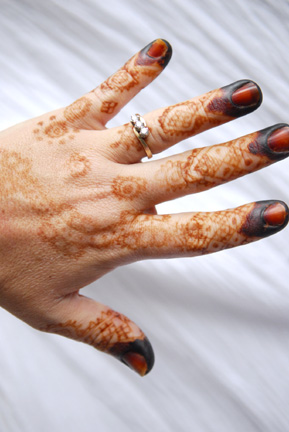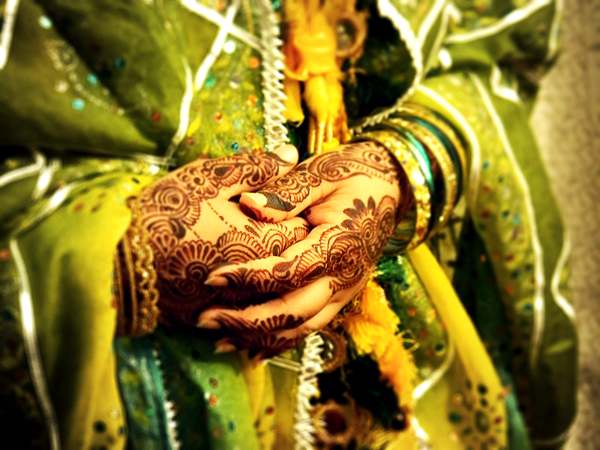How To Mix Henna For Hands Biography
source{gooogle.com.pk}Henna is a paste made from the crushed leaves and twigs of the henna plant, which is grown in South Asian and North African countries. When henna is applied to the skin, it leaves an stain ranging in color from orange to dark maroon that fades within 1 to 2 weeks. This guide will teach you to safely use henna for skin to create beautiful and sensual body art. The paste can be applied with many traditional and innovative tools, including resist, a cone, syringe, Jac bottle or fingers. A light stain may be achieved within minutes, the longer the paste is left on the skin, the stronger the stain will be, and should be left for several hours. To prevent it from drying or falling off the skin, the paste is often sealed down by dabbing a sugar/lemon mix over the dried paste, or simply adding some form of sugar to the paste. It is debatable whether this adds to the color of the end result; some believe it increases the intensity of the shade. After time the dry paste is simply brushed or scraped away. Henna stains are orange soon after application, but darken over the following three days to a reddish brown. Soles and palms have the thickest layer of skin and so take up the most lawsone, and take it to the greatest depth, so that hands and feet will have the darkest and most long-lasting stains. Steaming or warming the henna pattern will darken the stain, either during the time the paste is still on the skin, or after the paste has been removed. Chlorinated water and soaps may spoil the darkening process: alkaline products may hasten the darkening process. After the stain reaches its peak color it will appear to fade, as the stained dead cells exfoliate.
Henna has been used as a cosmetic hair dye for 6,000 years. In Ancient Egypt, it is known to have been worn. Henna has also traditionally been used for centuries in other parts of North Africa, the Horn of Africa, the Arabian Peninsula, the Near East and South Asia. In Ancient Egypt, Ahmose-Henuttamehu (17th Dynasty, 1574 BCE): Henuttamehu was probably a daughter of Seqenenre Tao and Ahmose Inhapy. Smith reports that the mummy of Henuttamehu's own hair had been dyed a bright red at the sides, probably with henna. In Europe, henna was popular among women connected to the aesthetic movement and the Pre-Raphaelite artists of England in the 1800s. The fashion for Orientalism led young women with a bohemian inclination to begin tinting their hair with henna. Dante Gabriel Rossetti's wife and muse, Elizabeth Siddal, had naturally bright red hair. Contrary to the cultural tradition in Britain that considered red hair unattractive, the Pre-Raphaelites fetishized red hair. Siddal was portrayed by Rossetti in many paintings that emphasized her flowing red hair. The other Pre-Raphaelites, including Evelyn De Morgan and Frederick Sandys, academic classicists such as Frederic Leighton, and French painters such as Gaston Bussière and the Impressionists further popularized the association of henna-dyed hair and young bohemian women. Opera singer Adelina Patti is sometimes credited with popularizing the use of henna in Europe in the late 1800s. Parisian courtesan Cora Pearl was often referred to as La Lune Rousse (the red moon) for dying her hair red. In her memoirs, she relates an incident when she dyed her pet dog's fur to match her own hair. By the 1950s, Lucille Ball popularized "henna rinse" as her character, Lucy Ricardo, called it on the television show I Love Lucy. It gained popularity among young people in the 1960s through growing interest in Eastern cultures. Muslim men may use henna as a dye for hair and most particularly their beards. This is considered a sunnah, a commendable tradition of the Prophet Muhammad. Furthermore, a hadith (narration of the Prophet) holds that he encouraged Muslim women to dye their nails with henna to demonstrate femininity and distinguish their hands from the hands of men; thus some Muslim women in the Middle East apply henna to their finger and toenails as well as their hands.
How To Mix Henna For Hands Henna Hands Pictures Images Pics

How To Mix Henna For Hands Henna Hands Pictures Images Pics
How To Mix Henna For Hands Henna Hands Pictures Images Pics

How To Mix Henna For Hands Henna Hands Pictures Images Pics

How To Mix Henna For Hands Henna Hands Pictures Images Pics

How To Mix Henna For Hands Henna Hands Pictures Images Pics

How To Mix Henna For Hands Henna Hands Pictures Images Pics

How To Mix Henna For Hands Henna Hands Pictures Images Pics

How To Mix Henna For Hands Henna Hands Pictures Images Pics

How To Mix Henna For Hands Henna Hands Pictures Images Pics

How To Mix Henna For Hands Henna Hands Pictures Images Pics
No comments:
Post a Comment